Analysis of UK's Current Account Balance and Balance of Payments
VerifiedAdded on 2023/01/12
|15
|3619
|27
Report
AI Summary
This report provides a comprehensive analysis of the UK's current account balance and balance of payments, examining the factors that influence these key economic indicators. The report explores the components of the balance of payments, including the current, capital, and financial accounts, and delves into the causes of fluctuations in the UK's current account balance, such as consumer spending, exchange rate variations, and trade deficits. It traces the historical trends in the UK's current account, highlighting periods of surplus and deficit and the underlying economic conditions. Furthermore, the report investigates the economic factors contributing to changes in balances and their linkage with the balance of payments, offering insights into the impact of government policies and global economic trends. The analysis includes discussions on trade deficits, investment income, and the role of supply-side policies in improving the UK's current account position. This study enhances the understanding of concepts related to international money and finance, providing valuable information for students and professionals alike.
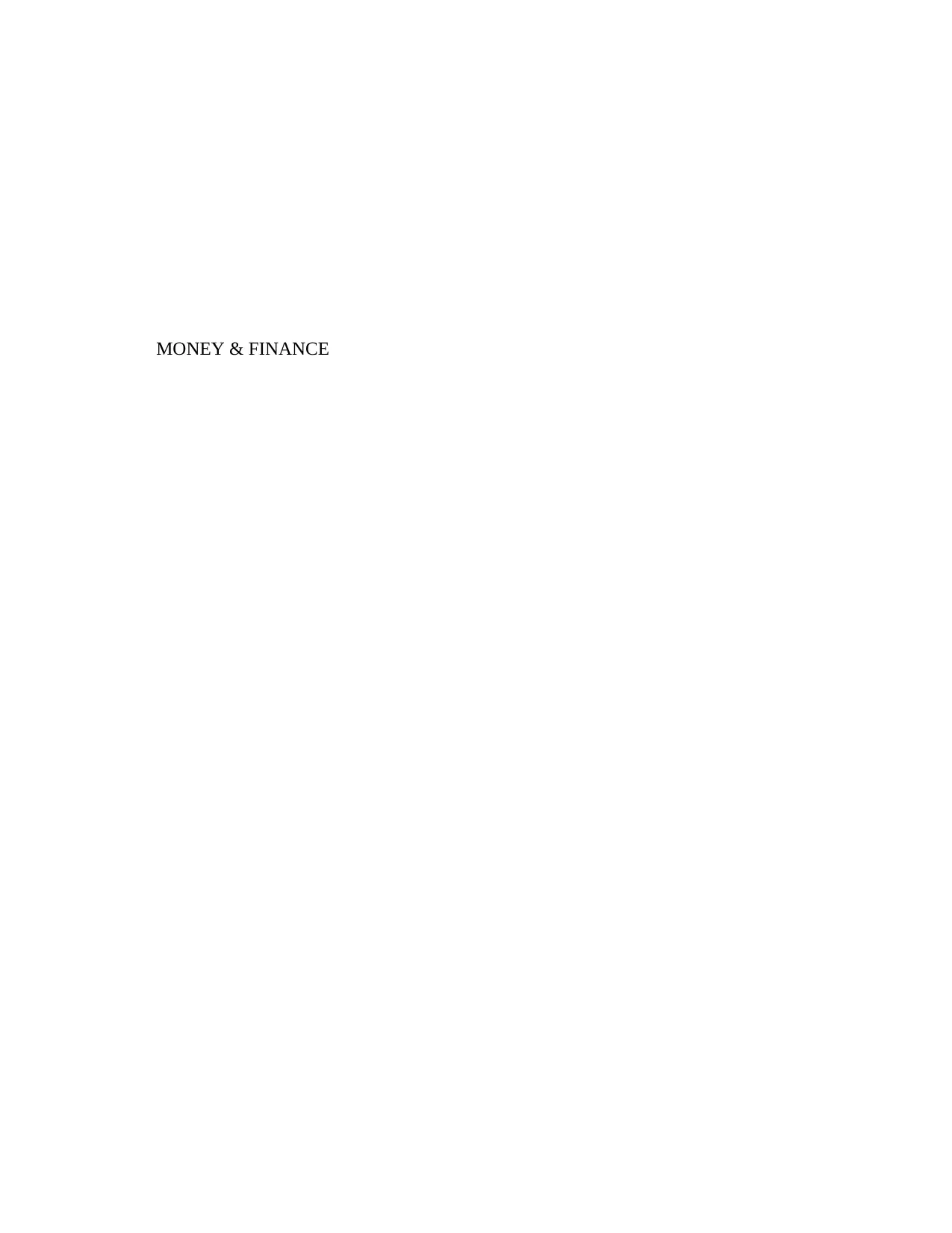
MONEY & FINANCE
Paraphrase This Document
Need a fresh take? Get an instant paraphrase of this document with our AI Paraphraser

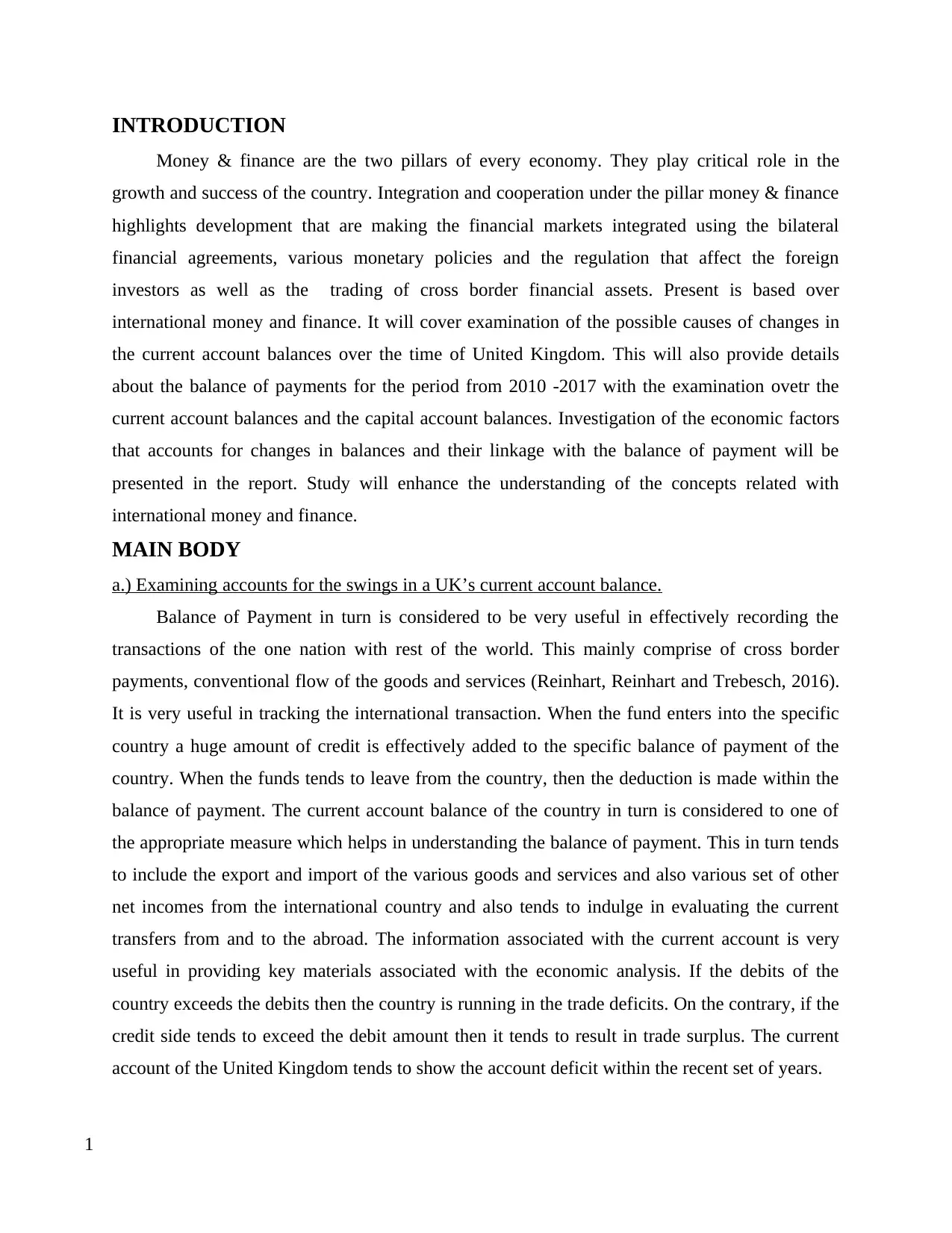
INTRODUCTION
Money & finance are the two pillars of every economy. They play critical role in the
growth and success of the country. Integration and cooperation under the pillar money & finance
highlights development that are making the financial markets integrated using the bilateral
financial agreements, various monetary policies and the regulation that affect the foreign
investors as well as the trading of cross border financial assets. Present is based over
international money and finance. It will cover examination of the possible causes of changes in
the current account balances over the time of United Kingdom. This will also provide details
about the balance of payments for the period from 2010 -2017 with the examination ovetr the
current account balances and the capital account balances. Investigation of the economic factors
that accounts for changes in balances and their linkage with the balance of payment will be
presented in the report. Study will enhance the understanding of the concepts related with
international money and finance.
MAIN BODY
a.) Examining accounts for the swings in a UK’s current account balance.
Balance of Payment in turn is considered to be very useful in effectively recording the
transactions of the one nation with rest of the world. This mainly comprise of cross border
payments, conventional flow of the goods and services (Reinhart, Reinhart and Trebesch, 2016).
It is very useful in tracking the international transaction. When the fund enters into the specific
country a huge amount of credit is effectively added to the specific balance of payment of the
country. When the funds tends to leave from the country, then the deduction is made within the
balance of payment. The current account balance of the country in turn is considered to one of
the appropriate measure which helps in understanding the balance of payment. This in turn tends
to include the export and import of the various goods and services and also various set of other
net incomes from the international country and also tends to indulge in evaluating the current
transfers from and to the abroad. The information associated with the current account is very
useful in providing key materials associated with the economic analysis. If the debits of the
country exceeds the debits then the country is running in the trade deficits. On the contrary, if the
credit side tends to exceed the debit amount then it tends to result in trade surplus. The current
account of the United Kingdom tends to show the account deficit within the recent set of years.
1
Money & finance are the two pillars of every economy. They play critical role in the
growth and success of the country. Integration and cooperation under the pillar money & finance
highlights development that are making the financial markets integrated using the bilateral
financial agreements, various monetary policies and the regulation that affect the foreign
investors as well as the trading of cross border financial assets. Present is based over
international money and finance. It will cover examination of the possible causes of changes in
the current account balances over the time of United Kingdom. This will also provide details
about the balance of payments for the period from 2010 -2017 with the examination ovetr the
current account balances and the capital account balances. Investigation of the economic factors
that accounts for changes in balances and their linkage with the balance of payment will be
presented in the report. Study will enhance the understanding of the concepts related with
international money and finance.
MAIN BODY
a.) Examining accounts for the swings in a UK’s current account balance.
Balance of Payment in turn is considered to be very useful in effectively recording the
transactions of the one nation with rest of the world. This mainly comprise of cross border
payments, conventional flow of the goods and services (Reinhart, Reinhart and Trebesch, 2016).
It is very useful in tracking the international transaction. When the fund enters into the specific
country a huge amount of credit is effectively added to the specific balance of payment of the
country. When the funds tends to leave from the country, then the deduction is made within the
balance of payment. The current account balance of the country in turn is considered to one of
the appropriate measure which helps in understanding the balance of payment. This in turn tends
to include the export and import of the various goods and services and also various set of other
net incomes from the international country and also tends to indulge in evaluating the current
transfers from and to the abroad. The information associated with the current account is very
useful in providing key materials associated with the economic analysis. If the debits of the
country exceeds the debits then the country is running in the trade deficits. On the contrary, if the
credit side tends to exceed the debit amount then it tends to result in trade surplus. The current
account of the United Kingdom tends to show the account deficit within the recent set of years.
1
⊘ This is a preview!⊘
Do you want full access?
Subscribe today to unlock all pages.

Trusted by 1+ million students worldwide
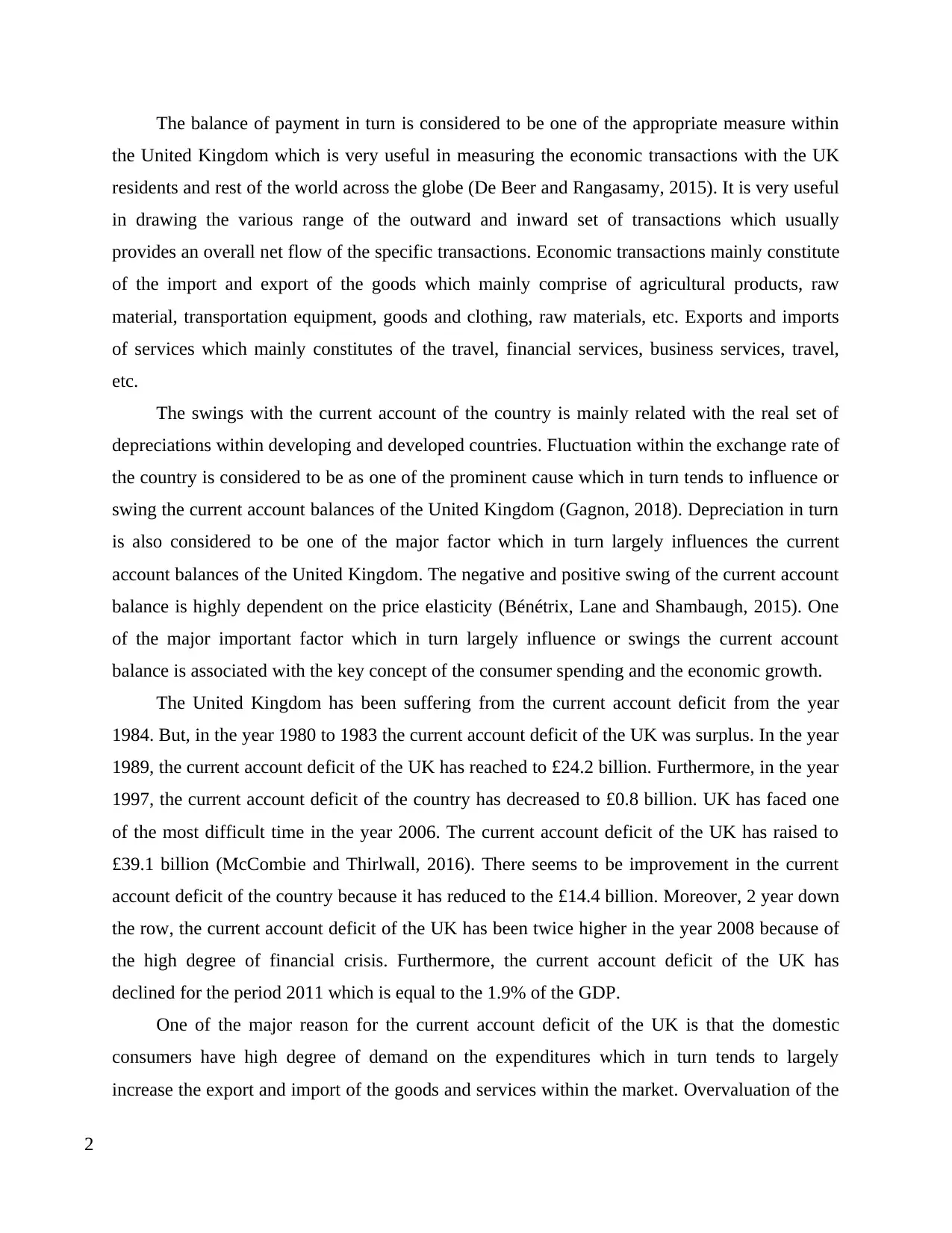
The balance of payment in turn is considered to be one of the appropriate measure within
the United Kingdom which is very useful in measuring the economic transactions with the UK
residents and rest of the world across the globe (De Beer and Rangasamy, 2015). It is very useful
in drawing the various range of the outward and inward set of transactions which usually
provides an overall net flow of the specific transactions. Economic transactions mainly constitute
of the import and export of the goods which mainly comprise of agricultural products, raw
material, transportation equipment, goods and clothing, raw materials, etc. Exports and imports
of services which mainly constitutes of the travel, financial services, business services, travel,
etc.
The swings with the current account of the country is mainly related with the real set of
depreciations within developing and developed countries. Fluctuation within the exchange rate of
the country is considered to be as one of the prominent cause which in turn tends to influence or
swing the current account balances of the United Kingdom (Gagnon, 2018). Depreciation in turn
is also considered to be one of the major factor which in turn largely influences the current
account balances of the United Kingdom. The negative and positive swing of the current account
balance is highly dependent on the price elasticity (Bénétrix, Lane and Shambaugh, 2015). One
of the major important factor which in turn largely influence or swings the current account
balance is associated with the key concept of the consumer spending and the economic growth.
The United Kingdom has been suffering from the current account deficit from the year
1984. But, in the year 1980 to 1983 the current account deficit of the UK was surplus. In the year
1989, the current account deficit of the UK has reached to £24.2 billion. Furthermore, in the year
1997, the current account deficit of the country has decreased to £0.8 billion. UK has faced one
of the most difficult time in the year 2006. The current account deficit of the UK has raised to
£39.1 billion (McCombie and Thirlwall, 2016). There seems to be improvement in the current
account deficit of the country because it has reduced to the £14.4 billion. Moreover, 2 year down
the row, the current account deficit of the UK has been twice higher in the year 2008 because of
the high degree of financial crisis. Furthermore, the current account deficit of the UK has
declined for the period 2011 which is equal to the 1.9% of the GDP.
One of the major reason for the current account deficit of the UK is that the domestic
consumers have high degree of demand on the expenditures which in turn tends to largely
increase the export and import of the goods and services within the market. Overvaluation of the
2
the United Kingdom which is very useful in measuring the economic transactions with the UK
residents and rest of the world across the globe (De Beer and Rangasamy, 2015). It is very useful
in drawing the various range of the outward and inward set of transactions which usually
provides an overall net flow of the specific transactions. Economic transactions mainly constitute
of the import and export of the goods which mainly comprise of agricultural products, raw
material, transportation equipment, goods and clothing, raw materials, etc. Exports and imports
of services which mainly constitutes of the travel, financial services, business services, travel,
etc.
The swings with the current account of the country is mainly related with the real set of
depreciations within developing and developed countries. Fluctuation within the exchange rate of
the country is considered to be as one of the prominent cause which in turn tends to influence or
swing the current account balances of the United Kingdom (Gagnon, 2018). Depreciation in turn
is also considered to be one of the major factor which in turn largely influences the current
account balances of the United Kingdom. The negative and positive swing of the current account
balance is highly dependent on the price elasticity (Bénétrix, Lane and Shambaugh, 2015). One
of the major important factor which in turn largely influence or swings the current account
balance is associated with the key concept of the consumer spending and the economic growth.
The United Kingdom has been suffering from the current account deficit from the year
1984. But, in the year 1980 to 1983 the current account deficit of the UK was surplus. In the year
1989, the current account deficit of the UK has reached to £24.2 billion. Furthermore, in the year
1997, the current account deficit of the country has decreased to £0.8 billion. UK has faced one
of the most difficult time in the year 2006. The current account deficit of the UK has raised to
£39.1 billion (McCombie and Thirlwall, 2016). There seems to be improvement in the current
account deficit of the country because it has reduced to the £14.4 billion. Moreover, 2 year down
the row, the current account deficit of the UK has been twice higher in the year 2008 because of
the high degree of financial crisis. Furthermore, the current account deficit of the UK has
declined for the period 2011 which is equal to the 1.9% of the GDP.
One of the major reason for the current account deficit of the UK is that the domestic
consumers have high degree of demand on the expenditures which in turn tends to largely
increase the export and import of the goods and services within the market. Overvaluation of the
2
Paraphrase This Document
Need a fresh take? Get an instant paraphrase of this document with our AI Paraphraser
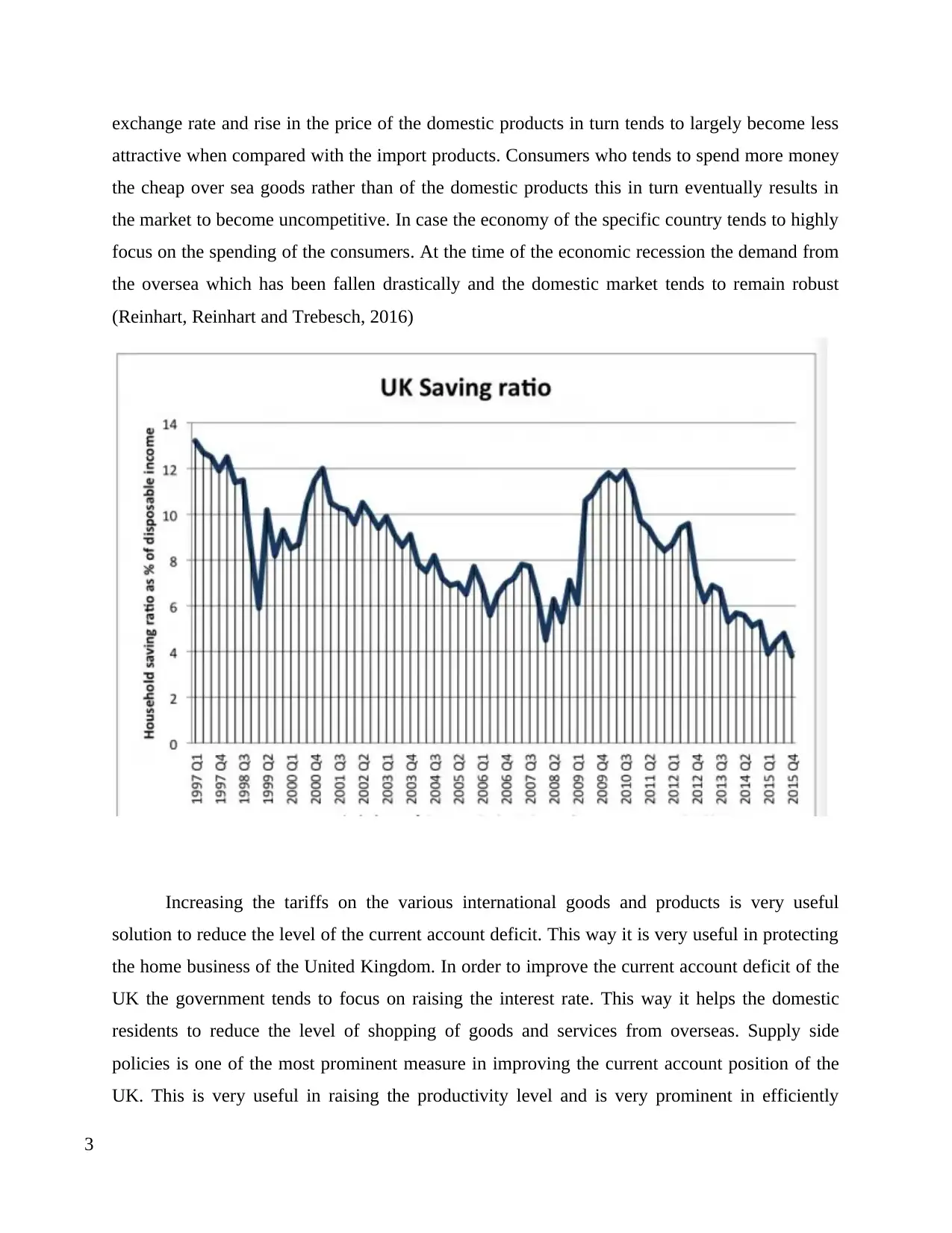
exchange rate and rise in the price of the domestic products in turn tends to largely become less
attractive when compared with the import products. Consumers who tends to spend more money
the cheap over sea goods rather than of the domestic products this in turn eventually results in
the market to become uncompetitive. In case the economy of the specific country tends to highly
focus on the spending of the consumers. At the time of the economic recession the demand from
the oversea which has been fallen drastically and the domestic market tends to remain robust
(Reinhart, Reinhart and Trebesch, 2016)
Increasing the tariffs on the various international goods and products is very useful
solution to reduce the level of the current account deficit. This way it is very useful in protecting
the home business of the United Kingdom. In order to improve the current account deficit of the
UK the government tends to focus on raising the interest rate. This way it helps the domestic
residents to reduce the level of shopping of goods and services from overseas. Supply side
policies is one of the most prominent measure in improving the current account position of the
UK. This is very useful in raising the productivity level and is very prominent in efficiently
3
attractive when compared with the import products. Consumers who tends to spend more money
the cheap over sea goods rather than of the domestic products this in turn eventually results in
the market to become uncompetitive. In case the economy of the specific country tends to highly
focus on the spending of the consumers. At the time of the economic recession the demand from
the oversea which has been fallen drastically and the domestic market tends to remain robust
(Reinhart, Reinhart and Trebesch, 2016)
Increasing the tariffs on the various international goods and products is very useful
solution to reduce the level of the current account deficit. This way it is very useful in protecting
the home business of the United Kingdom. In order to improve the current account deficit of the
UK the government tends to focus on raising the interest rate. This way it helps the domestic
residents to reduce the level of shopping of goods and services from overseas. Supply side
policies is one of the most prominent measure in improving the current account position of the
UK. This is very useful in raising the productivity level and is very prominent in efficiently
3
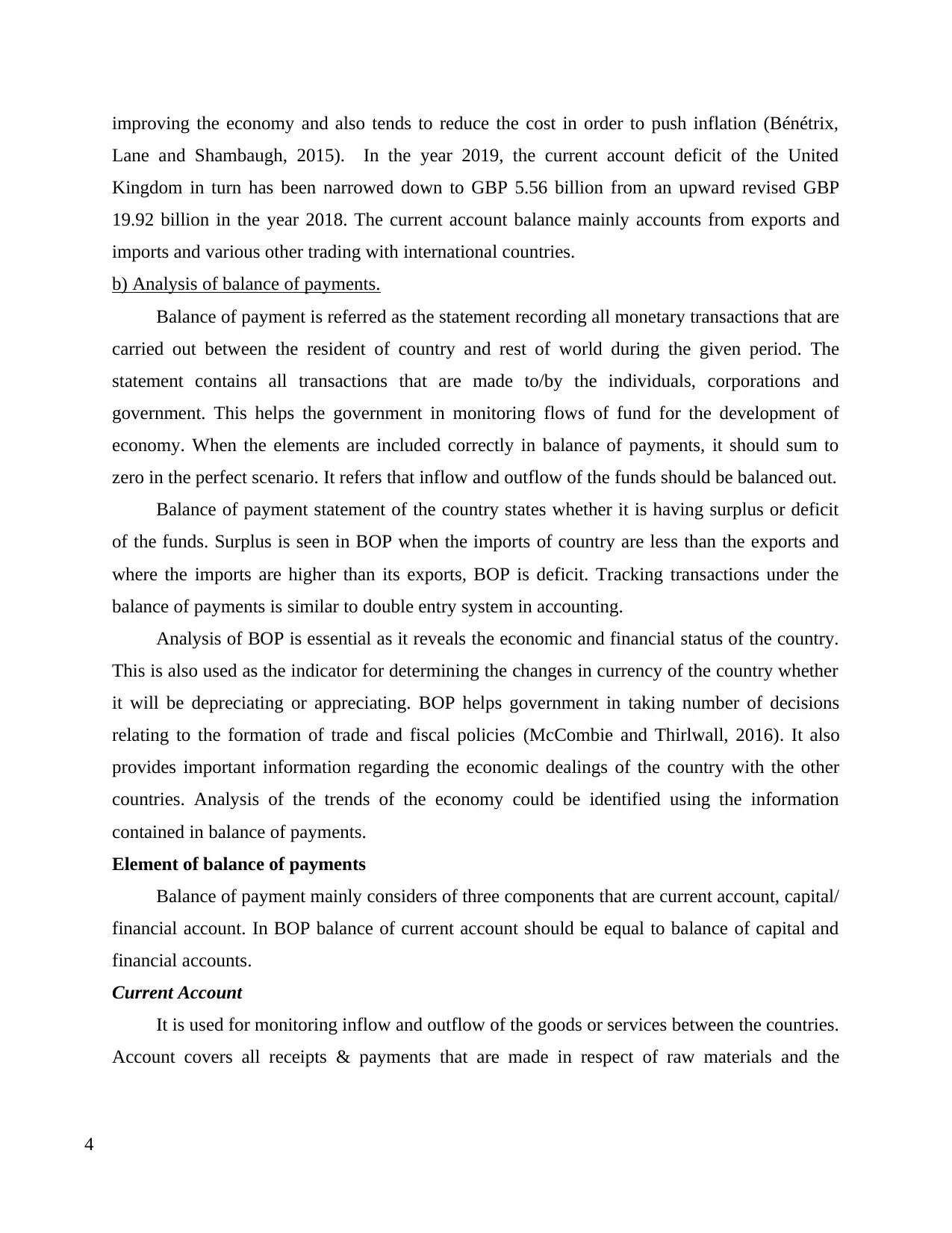
improving the economy and also tends to reduce the cost in order to push inflation (Bénétrix,
Lane and Shambaugh, 2015). In the year 2019, the current account deficit of the United
Kingdom in turn has been narrowed down to GBP 5.56 billion from an upward revised GBP
19.92 billion in the year 2018. The current account balance mainly accounts from exports and
imports and various other trading with international countries.
b) Analysis of balance of payments.
Balance of payment is referred as the statement recording all monetary transactions that are
carried out between the resident of country and rest of world during the given period. The
statement contains all transactions that are made to/by the individuals, corporations and
government. This helps the government in monitoring flows of fund for the development of
economy. When the elements are included correctly in balance of payments, it should sum to
zero in the perfect scenario. It refers that inflow and outflow of the funds should be balanced out.
Balance of payment statement of the country states whether it is having surplus or deficit
of the funds. Surplus is seen in BOP when the imports of country are less than the exports and
where the imports are higher than its exports, BOP is deficit. Tracking transactions under the
balance of payments is similar to double entry system in accounting.
Analysis of BOP is essential as it reveals the economic and financial status of the country.
This is also used as the indicator for determining the changes in currency of the country whether
it will be depreciating or appreciating. BOP helps government in taking number of decisions
relating to the formation of trade and fiscal policies (McCombie and Thirlwall, 2016). It also
provides important information regarding the economic dealings of the country with the other
countries. Analysis of the trends of the economy could be identified using the information
contained in balance of payments.
Element of balance of payments
Balance of payment mainly considers of three components that are current account, capital/
financial account. In BOP balance of current account should be equal to balance of capital and
financial accounts.
Current Account
It is used for monitoring inflow and outflow of the goods or services between the countries.
Account covers all receipts & payments that are made in respect of raw materials and the
4
Lane and Shambaugh, 2015). In the year 2019, the current account deficit of the United
Kingdom in turn has been narrowed down to GBP 5.56 billion from an upward revised GBP
19.92 billion in the year 2018. The current account balance mainly accounts from exports and
imports and various other trading with international countries.
b) Analysis of balance of payments.
Balance of payment is referred as the statement recording all monetary transactions that are
carried out between the resident of country and rest of world during the given period. The
statement contains all transactions that are made to/by the individuals, corporations and
government. This helps the government in monitoring flows of fund for the development of
economy. When the elements are included correctly in balance of payments, it should sum to
zero in the perfect scenario. It refers that inflow and outflow of the funds should be balanced out.
Balance of payment statement of the country states whether it is having surplus or deficit
of the funds. Surplus is seen in BOP when the imports of country are less than the exports and
where the imports are higher than its exports, BOP is deficit. Tracking transactions under the
balance of payments is similar to double entry system in accounting.
Analysis of BOP is essential as it reveals the economic and financial status of the country.
This is also used as the indicator for determining the changes in currency of the country whether
it will be depreciating or appreciating. BOP helps government in taking number of decisions
relating to the formation of trade and fiscal policies (McCombie and Thirlwall, 2016). It also
provides important information regarding the economic dealings of the country with the other
countries. Analysis of the trends of the economy could be identified using the information
contained in balance of payments.
Element of balance of payments
Balance of payment mainly considers of three components that are current account, capital/
financial account. In BOP balance of current account should be equal to balance of capital and
financial accounts.
Current Account
It is used for monitoring inflow and outflow of the goods or services between the countries.
Account covers all receipts & payments that are made in respect of raw materials and the
4
⊘ This is a preview!⊘
Do you want full access?
Subscribe today to unlock all pages.

Trusted by 1+ million students worldwide
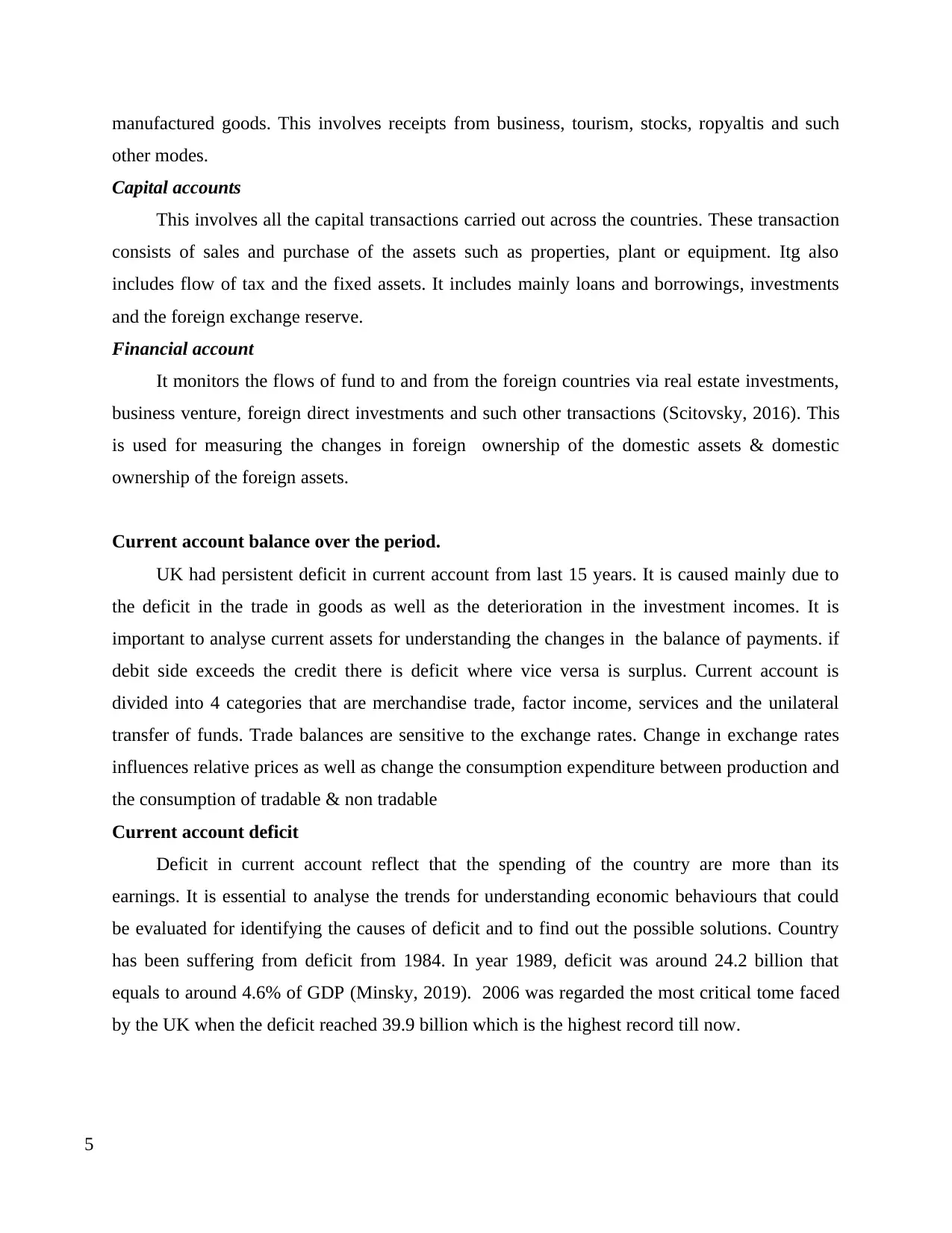
manufactured goods. This involves receipts from business, tourism, stocks, ropyaltis and such
other modes.
Capital accounts
This involves all the capital transactions carried out across the countries. These transaction
consists of sales and purchase of the assets such as properties, plant or equipment. Itg also
includes flow of tax and the fixed assets. It includes mainly loans and borrowings, investments
and the foreign exchange reserve.
Financial account
It monitors the flows of fund to and from the foreign countries via real estate investments,
business venture, foreign direct investments and such other transactions (Scitovsky, 2016). This
is used for measuring the changes in foreign ownership of the domestic assets & domestic
ownership of the foreign assets.
Current account balance over the period.
UK had persistent deficit in current account from last 15 years. It is caused mainly due to
the deficit in the trade in goods as well as the deterioration in the investment incomes. It is
important to analyse current assets for understanding the changes in the balance of payments. if
debit side exceeds the credit there is deficit where vice versa is surplus. Current account is
divided into 4 categories that are merchandise trade, factor income, services and the unilateral
transfer of funds. Trade balances are sensitive to the exchange rates. Change in exchange rates
influences relative prices as well as change the consumption expenditure between production and
the consumption of tradable & non tradable
Current account deficit
Deficit in current account reflect that the spending of the country are more than its
earnings. It is essential to analyse the trends for understanding economic behaviours that could
be evaluated for identifying the causes of deficit and to find out the possible solutions. Country
has been suffering from deficit from 1984. In year 1989, deficit was around 24.2 billion that
equals to around 4.6% of GDP (Minsky, 2019). 2006 was regarded the most critical tome faced
by the UK when the deficit reached 39.9 billion which is the highest record till now.
5
other modes.
Capital accounts
This involves all the capital transactions carried out across the countries. These transaction
consists of sales and purchase of the assets such as properties, plant or equipment. Itg also
includes flow of tax and the fixed assets. It includes mainly loans and borrowings, investments
and the foreign exchange reserve.
Financial account
It monitors the flows of fund to and from the foreign countries via real estate investments,
business venture, foreign direct investments and such other transactions (Scitovsky, 2016). This
is used for measuring the changes in foreign ownership of the domestic assets & domestic
ownership of the foreign assets.
Current account balance over the period.
UK had persistent deficit in current account from last 15 years. It is caused mainly due to
the deficit in the trade in goods as well as the deterioration in the investment incomes. It is
important to analyse current assets for understanding the changes in the balance of payments. if
debit side exceeds the credit there is deficit where vice versa is surplus. Current account is
divided into 4 categories that are merchandise trade, factor income, services and the unilateral
transfer of funds. Trade balances are sensitive to the exchange rates. Change in exchange rates
influences relative prices as well as change the consumption expenditure between production and
the consumption of tradable & non tradable
Current account deficit
Deficit in current account reflect that the spending of the country are more than its
earnings. It is essential to analyse the trends for understanding economic behaviours that could
be evaluated for identifying the causes of deficit and to find out the possible solutions. Country
has been suffering from deficit from 1984. In year 1989, deficit was around 24.2 billion that
equals to around 4.6% of GDP (Minsky, 2019). 2006 was regarded the most critical tome faced
by the UK when the deficit reached 39.9 billion which is the highest record till now.
5
Paraphrase This Document
Need a fresh take? Get an instant paraphrase of this document with our AI Paraphraser
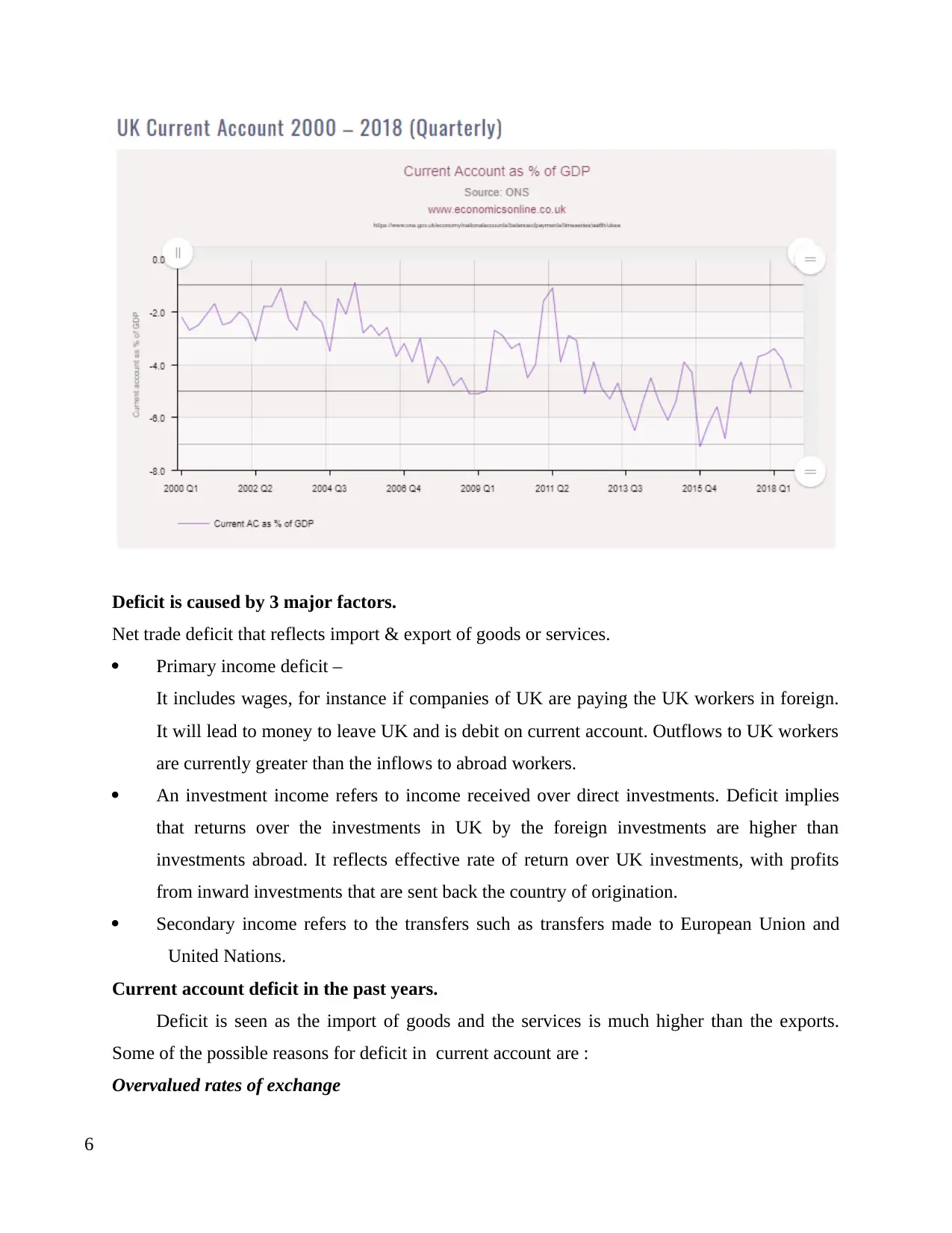
Deficit is caused by 3 major factors.
Net trade deficit that reflects import & export of goods or services.
Primary income deficit –
It includes wages, for instance if companies of UK are paying the UK workers in foreign.
It will lead to money to leave UK and is debit on current account. Outflows to UK workers
are currently greater than the inflows to abroad workers.
An investment income refers to income received over direct investments. Deficit implies
that returns over the investments in UK by the foreign investments are higher than
investments abroad. It reflects effective rate of return over UK investments, with profits
from inward investments that are sent back the country of origination.
Secondary income refers to the transfers such as transfers made to European Union and
United Nations.
Current account deficit in the past years.
Deficit is seen as the import of goods and the services is much higher than the exports.
Some of the possible reasons for deficit in current account are :
Overvalued rates of exchange
6
Net trade deficit that reflects import & export of goods or services.
Primary income deficit –
It includes wages, for instance if companies of UK are paying the UK workers in foreign.
It will lead to money to leave UK and is debit on current account. Outflows to UK workers
are currently greater than the inflows to abroad workers.
An investment income refers to income received over direct investments. Deficit implies
that returns over the investments in UK by the foreign investments are higher than
investments abroad. It reflects effective rate of return over UK investments, with profits
from inward investments that are sent back the country of origination.
Secondary income refers to the transfers such as transfers made to European Union and
United Nations.
Current account deficit in the past years.
Deficit is seen as the import of goods and the services is much higher than the exports.
Some of the possible reasons for deficit in current account are :
Overvalued rates of exchange
6
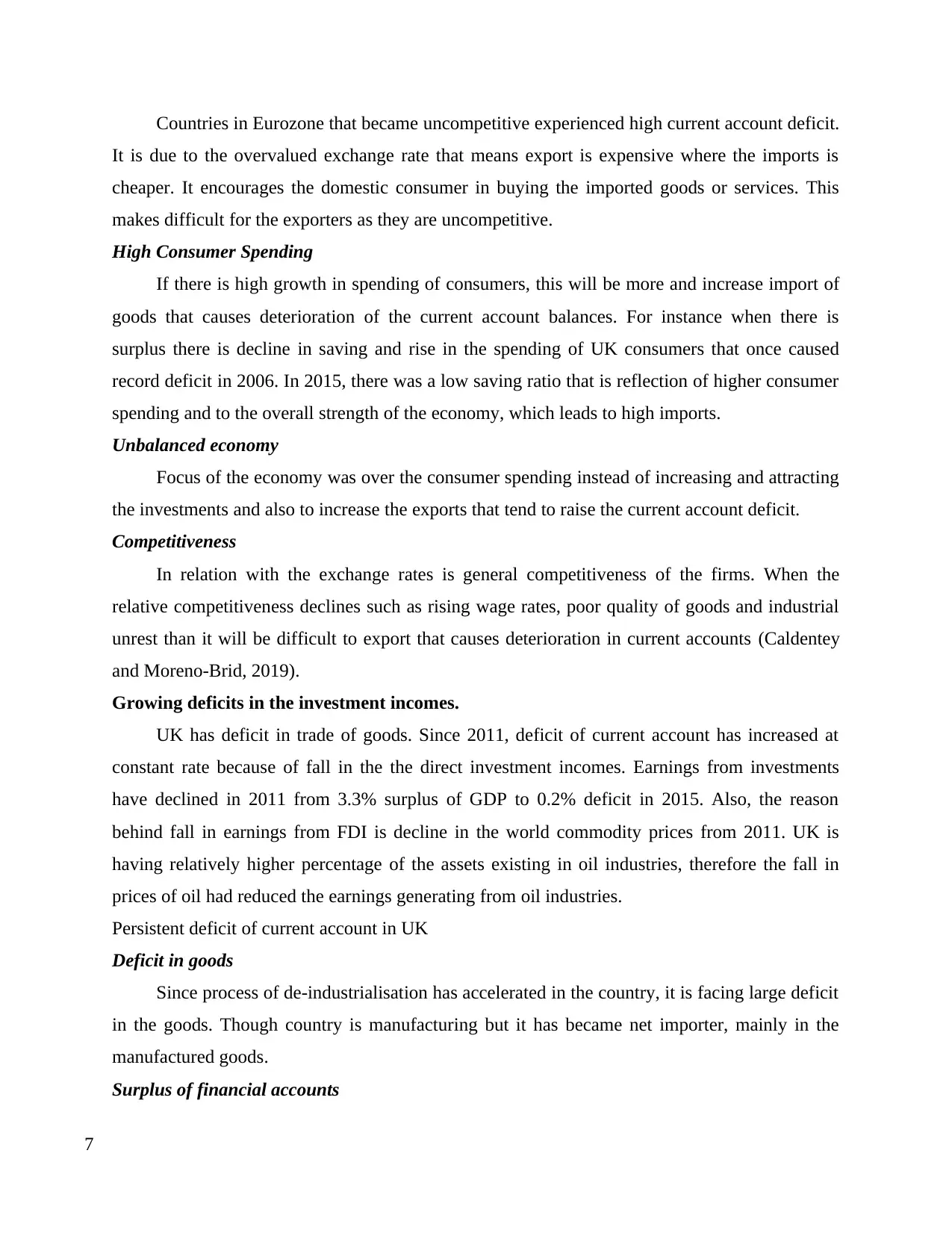
Countries in Eurozone that became uncompetitive experienced high current account deficit.
It is due to the overvalued exchange rate that means export is expensive where the imports is
cheaper. It encourages the domestic consumer in buying the imported goods or services. This
makes difficult for the exporters as they are uncompetitive.
High Consumer Spending
If there is high growth in spending of consumers, this will be more and increase import of
goods that causes deterioration of the current account balances. For instance when there is
surplus there is decline in saving and rise in the spending of UK consumers that once caused
record deficit in 2006. In 2015, there was a low saving ratio that is reflection of higher consumer
spending and to the overall strength of the economy, which leads to high imports.
Unbalanced economy
Focus of the economy was over the consumer spending instead of increasing and attracting
the investments and also to increase the exports that tend to raise the current account deficit.
Competitiveness
In relation with the exchange rates is general competitiveness of the firms. When the
relative competitiveness declines such as rising wage rates, poor quality of goods and industrial
unrest than it will be difficult to export that causes deterioration in current accounts (Caldentey
and Moreno-Brid, 2019).
Growing deficits in the investment incomes.
UK has deficit in trade of goods. Since 2011, deficit of current account has increased at
constant rate because of fall in the the direct investment incomes. Earnings from investments
have declined in 2011 from 3.3% surplus of GDP to 0.2% deficit in 2015. Also, the reason
behind fall in earnings from FDI is decline in the world commodity prices from 2011. UK is
having relatively higher percentage of the assets existing in oil industries, therefore the fall in
prices of oil had reduced the earnings generating from oil industries.
Persistent deficit of current account in UK
Deficit in goods
Since process of de-industrialisation has accelerated in the country, it is facing large deficit
in the goods. Though country is manufacturing but it has became net importer, mainly in the
manufactured goods.
Surplus of financial accounts
7
It is due to the overvalued exchange rate that means export is expensive where the imports is
cheaper. It encourages the domestic consumer in buying the imported goods or services. This
makes difficult for the exporters as they are uncompetitive.
High Consumer Spending
If there is high growth in spending of consumers, this will be more and increase import of
goods that causes deterioration of the current account balances. For instance when there is
surplus there is decline in saving and rise in the spending of UK consumers that once caused
record deficit in 2006. In 2015, there was a low saving ratio that is reflection of higher consumer
spending and to the overall strength of the economy, which leads to high imports.
Unbalanced economy
Focus of the economy was over the consumer spending instead of increasing and attracting
the investments and also to increase the exports that tend to raise the current account deficit.
Competitiveness
In relation with the exchange rates is general competitiveness of the firms. When the
relative competitiveness declines such as rising wage rates, poor quality of goods and industrial
unrest than it will be difficult to export that causes deterioration in current accounts (Caldentey
and Moreno-Brid, 2019).
Growing deficits in the investment incomes.
UK has deficit in trade of goods. Since 2011, deficit of current account has increased at
constant rate because of fall in the the direct investment incomes. Earnings from investments
have declined in 2011 from 3.3% surplus of GDP to 0.2% deficit in 2015. Also, the reason
behind fall in earnings from FDI is decline in the world commodity prices from 2011. UK is
having relatively higher percentage of the assets existing in oil industries, therefore the fall in
prices of oil had reduced the earnings generating from oil industries.
Persistent deficit of current account in UK
Deficit in goods
Since process of de-industrialisation has accelerated in the country, it is facing large deficit
in the goods. Though country is manufacturing but it has became net importer, mainly in the
manufactured goods.
Surplus of financial accounts
7
⊘ This is a preview!⊘
Do you want full access?
Subscribe today to unlock all pages.

Trusted by 1+ million students worldwide
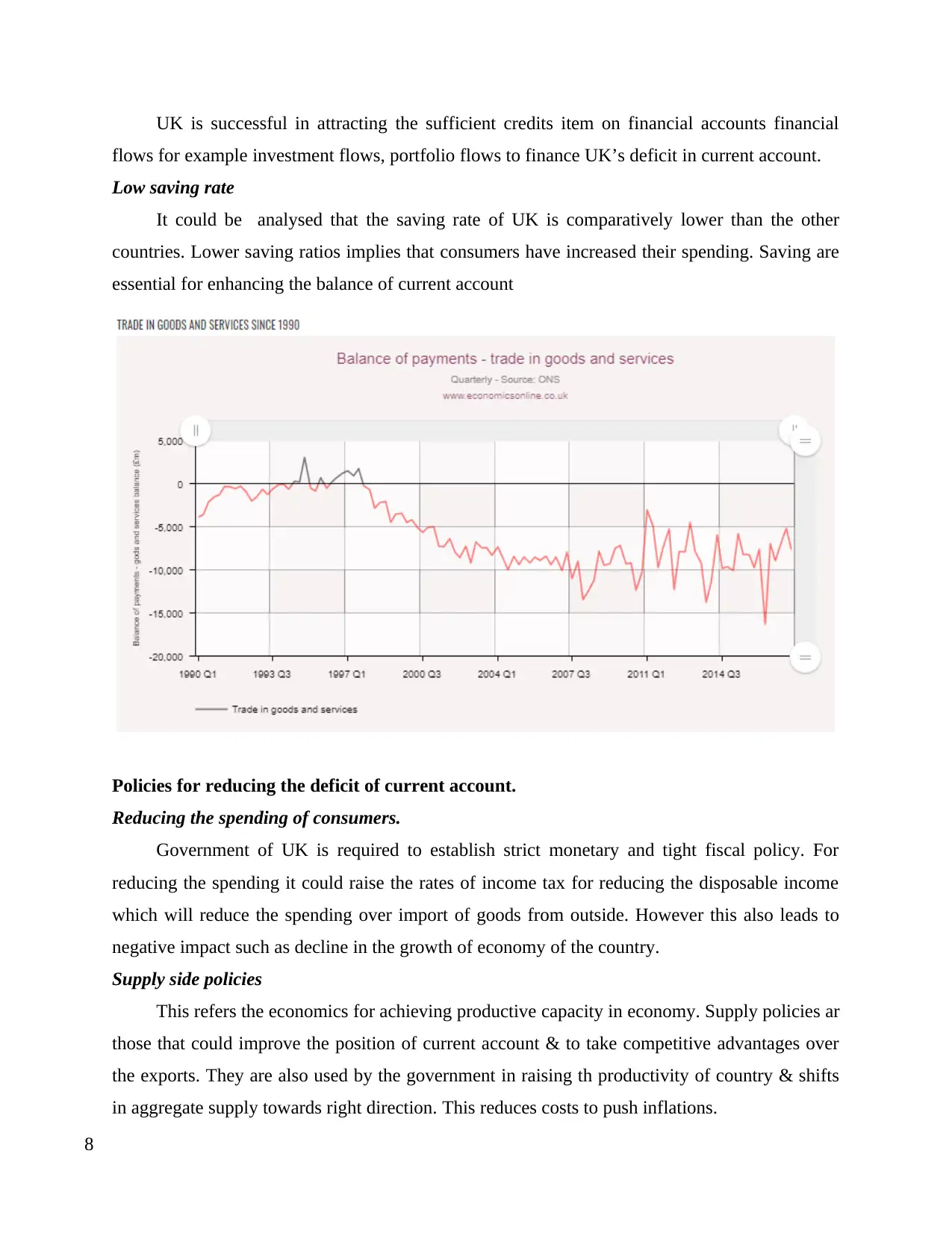
UK is successful in attracting the sufficient credits item on financial accounts financial
flows for example investment flows, portfolio flows to finance UK’s deficit in current account.
Low saving rate
It could be analysed that the saving rate of UK is comparatively lower than the other
countries. Lower saving ratios implies that consumers have increased their spending. Saving are
essential for enhancing the balance of current account
Policies for reducing the deficit of current account.
Reducing the spending of consumers.
Government of UK is required to establish strict monetary and tight fiscal policy. For
reducing the spending it could raise the rates of income tax for reducing the disposable income
which will reduce the spending over import of goods from outside. However this also leads to
negative impact such as decline in the growth of economy of the country.
Supply side policies
This refers the economics for achieving productive capacity in economy. Supply policies ar
those that could improve the position of current account & to take competitive advantages over
the exports. They are also used by the government in raising th productivity of country & shifts
in aggregate supply towards right direction. This reduces costs to push inflations.
8
flows for example investment flows, portfolio flows to finance UK’s deficit in current account.
Low saving rate
It could be analysed that the saving rate of UK is comparatively lower than the other
countries. Lower saving ratios implies that consumers have increased their spending. Saving are
essential for enhancing the balance of current account
Policies for reducing the deficit of current account.
Reducing the spending of consumers.
Government of UK is required to establish strict monetary and tight fiscal policy. For
reducing the spending it could raise the rates of income tax for reducing the disposable income
which will reduce the spending over import of goods from outside. However this also leads to
negative impact such as decline in the growth of economy of the country.
Supply side policies
This refers the economics for achieving productive capacity in economy. Supply policies ar
those that could improve the position of current account & to take competitive advantages over
the exports. They are also used by the government in raising th productivity of country & shifts
in aggregate supply towards right direction. This reduces costs to push inflations.
8
Paraphrase This Document
Need a fresh take? Get an instant paraphrase of this document with our AI Paraphraser
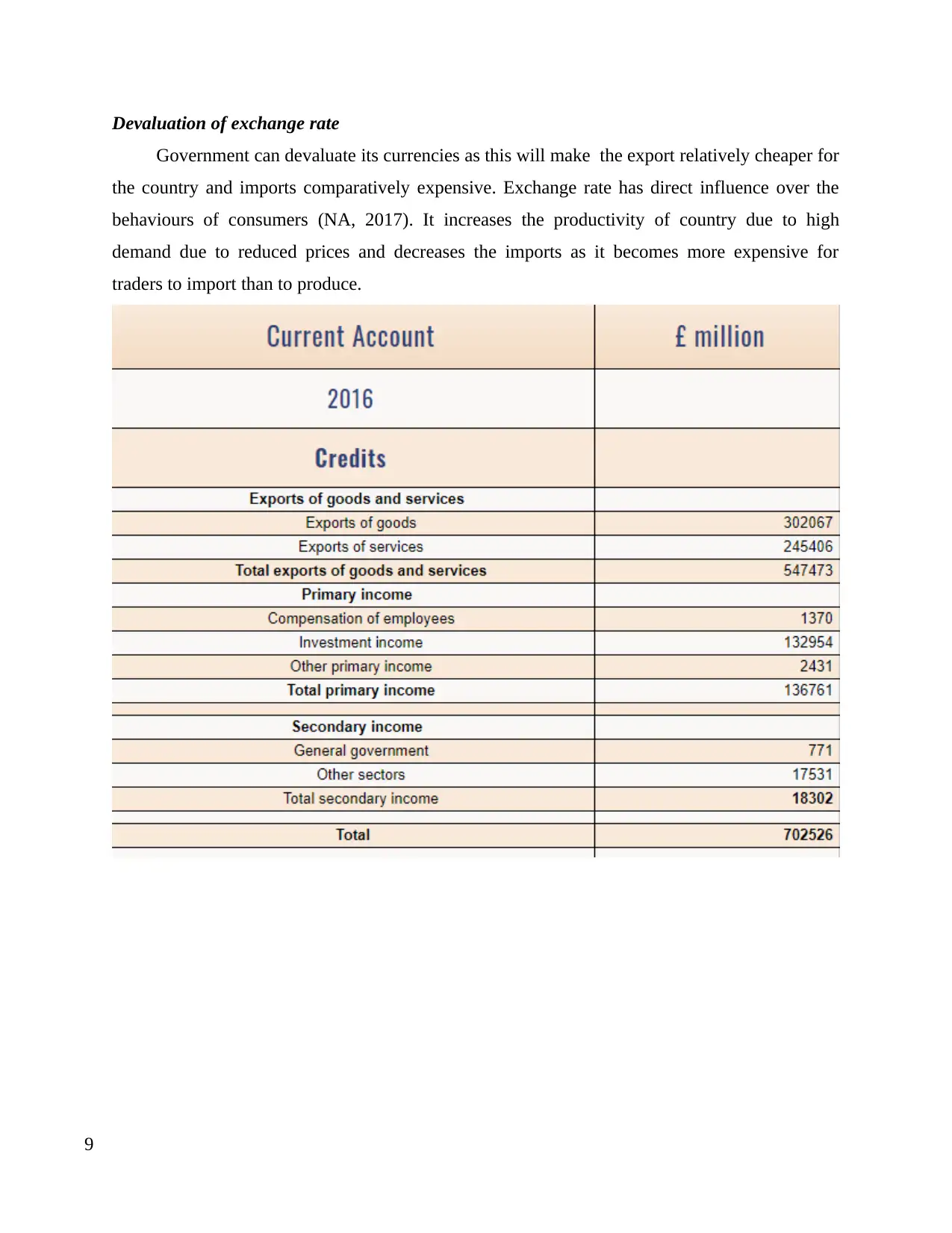
Devaluation of exchange rate
Government can devaluate its currencies as this will make the export relatively cheaper for
the country and imports comparatively expensive. Exchange rate has direct influence over the
behaviours of consumers (NA, 2017). It increases the productivity of country due to high
demand due to reduced prices and decreases the imports as it becomes more expensive for
traders to import than to produce.
9
Government can devaluate its currencies as this will make the export relatively cheaper for
the country and imports comparatively expensive. Exchange rate has direct influence over the
behaviours of consumers (NA, 2017). It increases the productivity of country due to high
demand due to reduced prices and decreases the imports as it becomes more expensive for
traders to import than to produce.
9
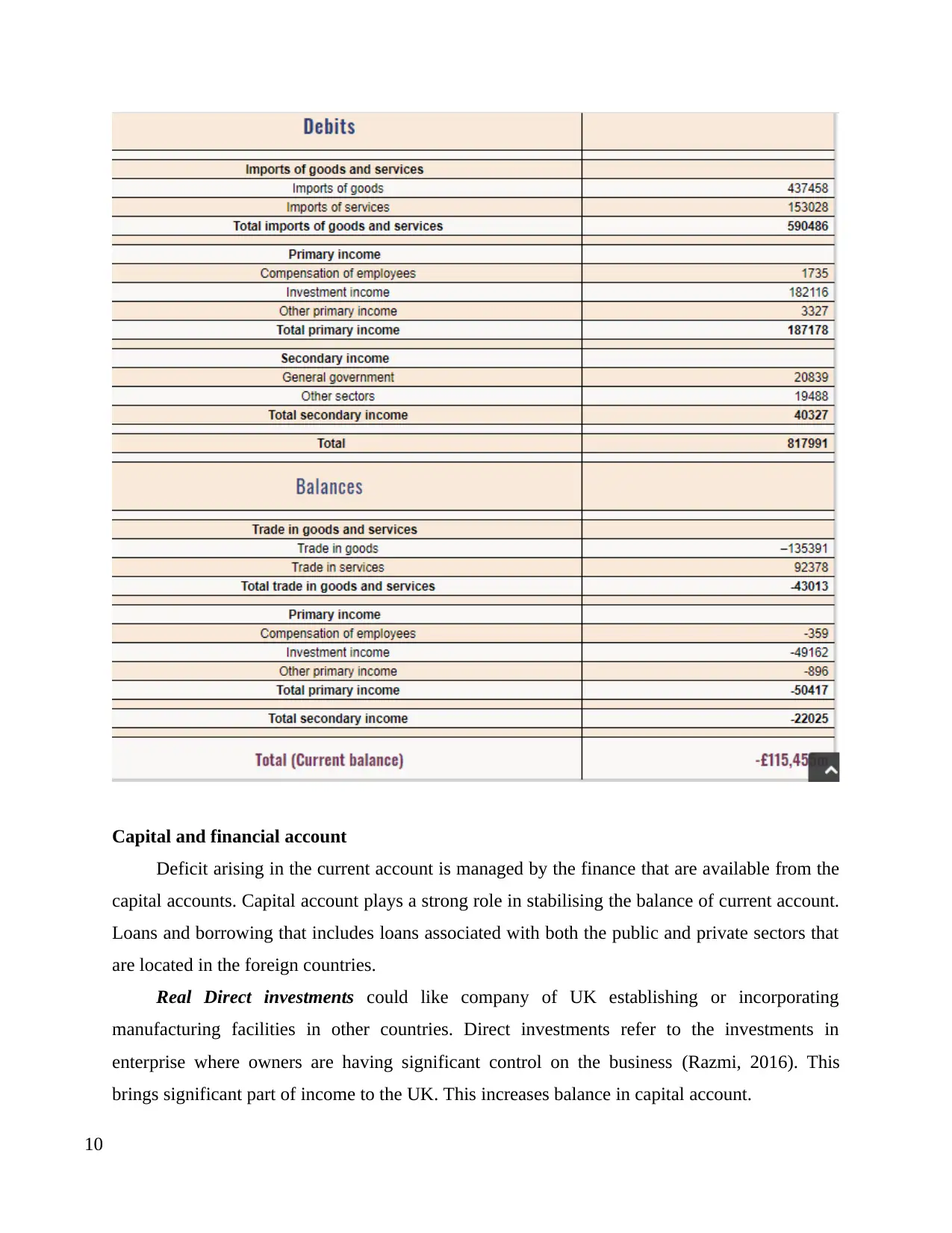
Capital and financial account
Deficit arising in the current account is managed by the finance that are available from the
capital accounts. Capital account plays a strong role in stabilising the balance of current account.
Loans and borrowing that includes loans associated with both the public and private sectors that
are located in the foreign countries.
Real Direct investments could like company of UK establishing or incorporating
manufacturing facilities in other countries. Direct investments refer to the investments in
enterprise where owners are having significant control on the business (Razmi, 2016). This
brings significant part of income to the UK. This increases balance in capital account.
10
Deficit arising in the current account is managed by the finance that are available from the
capital accounts. Capital account plays a strong role in stabilising the balance of current account.
Loans and borrowing that includes loans associated with both the public and private sectors that
are located in the foreign countries.
Real Direct investments could like company of UK establishing or incorporating
manufacturing facilities in other countries. Direct investments refer to the investments in
enterprise where owners are having significant control on the business (Razmi, 2016). This
brings significant part of income to the UK. This increases balance in capital account.
10
⊘ This is a preview!⊘
Do you want full access?
Subscribe today to unlock all pages.

Trusted by 1+ million students worldwide
1 out of 15
Related Documents
Your All-in-One AI-Powered Toolkit for Academic Success.
+13062052269
info@desklib.com
Available 24*7 on WhatsApp / Email
![[object Object]](/_next/static/media/star-bottom.7253800d.svg)
Unlock your academic potential
Copyright © 2020–2025 A2Z Services. All Rights Reserved. Developed and managed by ZUCOL.




